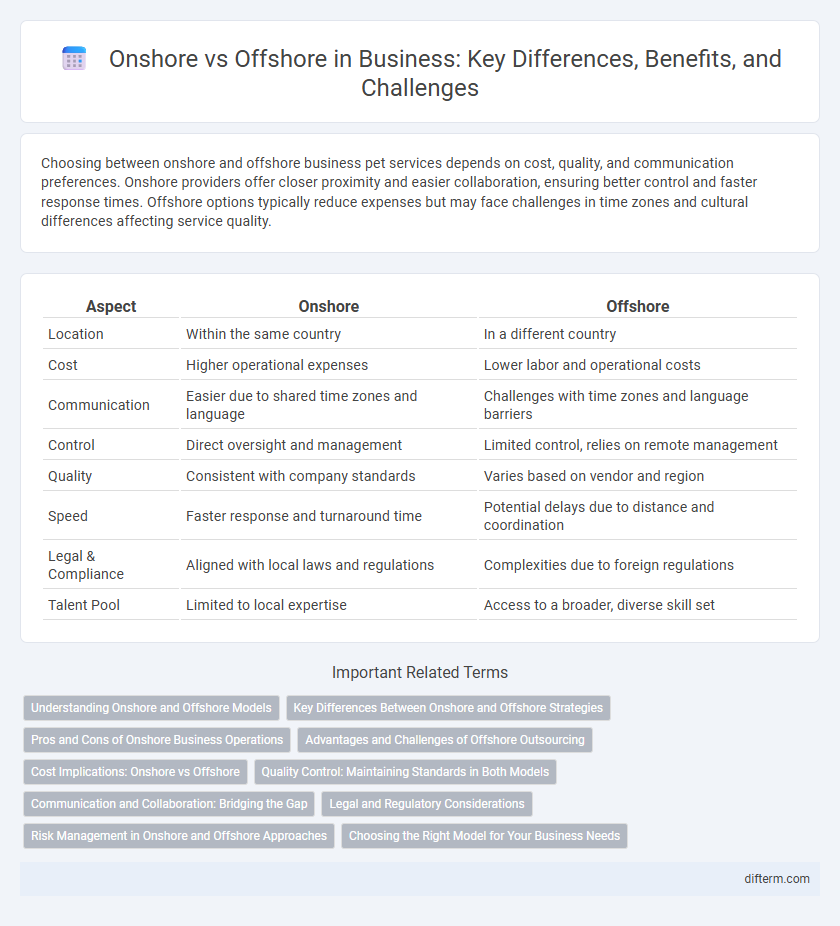Choosing between onshore and offshore business pet services depends on cost, quality, and communication preferences. Onshore providers offer closer proximity and easier collaboration, ensuring better control and faster response times. Offshore options typically reduce expenses but may face challenges in time zones and cultural differences affecting service quality.
Table of Comparison
| Aspect | Onshore | Offshore |
|---|---|---|
| Location | Within the same country | In a different country |
| Cost | Higher operational expenses | Lower labor and operational costs |
| Communication | Easier due to shared time zones and language | Challenges with time zones and language barriers |
| Control | Direct oversight and management | Limited control, relies on remote management |
| Quality | Consistent with company standards | Varies based on vendor and region |
| Speed | Faster response and turnaround time | Potential delays due to distance and coordination |
| Legal & Compliance | Aligned with local laws and regulations | Complexities due to foreign regulations |
| Talent Pool | Limited to local expertise | Access to a broader, diverse skill set |
Understanding Onshore and Offshore Models
Onshore and offshore business models differ primarily in geographic location and cost structures, with onshore operations situated within the same country as the client, ensuring easier communication and regulatory compliance. Offshore models leverage distant countries with lower labor costs to maximize savings and access specialized skills, often involving time zone challenges. Choosing between these models depends on factors like budget, control preferences, and desired speed of delivery.
Key Differences Between Onshore and Offshore Strategies
Onshore strategies involve utilizing local resources and facilities within the same country, offering advantages such as easier communication, cultural alignment, and faster response times. Offshore strategies leverage resources in foreign countries, often to capitalize on cost savings, access specialized skills, and extend operational hours across time zones. Key differences lie in cost structure, control over processes, risk management, and the level of direct oversight businesses maintain over their projects.
Pros and Cons of Onshore Business Operations
Onshore business operations provide advantages such as enhanced communication, easier regulatory compliance, and greater control over processes, ensuring higher quality and faster response times. However, they often come with higher labor and operational costs compared to offshore alternatives, which can impact profitability. Companies must weigh these factors to determine whether onshore operations align with their strategic priorities and budget constraints.
Advantages and Challenges of Offshore Outsourcing
Offshore outsourcing offers cost savings by leveraging lower labor expenses in countries like India and the Philippines, while providing access to specialized skills and around-the-clock operations. Challenges include communication barriers due to time zone differences and cultural disparities, which can impact project timelines and quality control. Effective management and strategic collaboration are essential to mitigate risks and maximize the benefits of offshore partnerships in the global marketplace.
Cost Implications: Onshore vs Offshore
Onshore services typically incur higher labor and operational costs due to local wage standards and regulatory compliance, impacting overall project budgets. Offshore outsourcing offers significant cost savings by leveraging lower wage markets and reduced overhead expenses, though it may introduce hidden costs such as communication barriers and time zone differences. Careful cost-benefit analysis is essential to balance immediate financial gains with long-term operational efficiency in onshore versus offshore decisions.
Quality Control: Maintaining Standards in Both Models
Onshore quality control ensures product standards through direct oversight, real-time communication, and strict adherence to local regulations, minimizing errors and enhancing customer satisfaction. Offshore quality control faces challenges like time zone differences and cultural barriers but leverages technology-driven inspections and standardized processes to maintain consistency. Both models require tailored quality management systems to uphold compliance, reduce defects, and achieve operational excellence in global supply chains.
Communication and Collaboration: Bridging the Gap
Effective communication and collaboration between onshore and offshore teams hinge on leveraging advanced digital tools and establishing clear protocols to bridge cultural and time zone differences. Regular synchronous meetings and transparent project management platforms ensure alignment and foster trust despite geographical separation. Emphasizing cultural awareness training enhances mutual understanding and mitigates miscommunication, driving seamless teamwork and project success.
Legal and Regulatory Considerations
Onshore business operations must comply with domestic legal frameworks, including labor laws, tax regulations, and data protection standards specific to the country of operation. Offshore entities face complex regulatory challenges such as navigating foreign compliance requirements, international tax treaties, and potential exposure to anti-bribery laws like the Foreign Corrupt Practices Act (FCPA). Understanding jurisdiction-specific legal risks and adhering to both local and international regulations is critical for mitigating penalties and ensuring sustainable business practices.
Risk Management in Onshore and Offshore Approaches
Onshore risk management benefits from greater regulatory oversight and proximity, enabling faster response times and enhanced control over project outcomes. Offshore approaches face challenges such as geopolitical instability, currency fluctuations, and communication barriers, which require robust mitigation strategies to ensure operational continuity. Companies must tailor risk assessments to address location-specific threats while leveraging technology and local expertise to minimize vulnerabilities.
Choosing the Right Model for Your Business Needs
Selecting between onshore and offshore business models depends on key factors such as cost efficiency, talent availability, and operational control. Onshore solutions offer proximity and ease of communication, ideal for projects requiring close collaboration and quick turnaround. Offshore models provide significant cost savings and access to a diverse talent pool, making them suitable for scalable and resource-intensive operations.
Onshore vs Offshore Infographic

 difterm.com
difterm.com